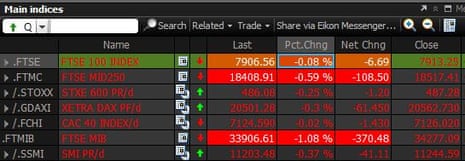China raises tariffs on US goods to 125%
BREAKING: China has announced additional tariffs on US goods to 125%, according to Reuters.
That is up from the previous level of 84%.
China’s finance ministry is reported as saying that if the US insists on continuing to infringe upon China’s interest in a substantive way, China will resolutely take countermeasures and fight to the end.
Key events
JD.com, one of China’s biggest online retailers, is ramping up subsidies to help businesses pivot towards the domestic Chinese market.
The e-commerce giant has announced that it will launch a 200 billion yuan fund (£20.8bn) to help exporters sell their products domestically, in reaction to the intensifying US-China trade war, Reuters reports.
JD.com shares have taken a hit as a result of Trumps tariff announcements, with its stock down 10.6% for the month.
US stock futures fall into negative territory
US futures are pointing to a negative start for all the major indexes on Wall Street this afternoon, amid the escalating trade war.
S&P futures are down 0.75%, Dow futures are down 0.77% and Nasdaq futures are down 0.8%.

Helen Davidson
China has raised its tariffs on US products to 125% in the latest salvo of the trade dispute with Washington, just hours after Xi Jinping said there were “no winners in a tariff war”.
Xi made the comments during a meeting with the Spanish prime minister in which he invited the EU to work with China to resist “bullying”, part of an apparent campaign to shore up other trading partners.
The Chinese commerce ministry announced on Friday that it was raising the 84% tariffs on all US imports to 125%, again saying that China was ready to “fight to the end”.
The statement also suggested it may be Beijing’s last move in the tit-for-tat tariff raises as “at the current tariff level, there is no market acceptance for US goods exported to China”.
“If the US continues to impose tariffs on Chinese goods exported to the US, China will ignore it,” it said, flagging that there were other countermeasures to come.
Chinese officials have been canvassing other trading partners about how to deal with the US tariffs, after the country was excluded from Trump’s 90-day pause of the steepest global tariffs.
Instead the US president made consecutive increases to duties on Chinese imports, which are now 145%.
Read the full story here:
US dollar falls to three-year low
The US dollar has suffered a further blow as a result of Beijing’s 125% tariff announcement.
The US dollar index is now down 1.2% at 99.50, marking its lowest level since April 2022.
The relief rally this morning was certainly short-lived.
Here’s how the major European stock indexes are trading following latest escalation in the US-China trade war:

European markets are now predominantly in the red, as investors digest Beijing’s latest tariff announcement.
Chinese ministers are admonishing the US, calling for reversals from the Trump administration and declaring the Beijing will not back down, according to comments reported by Reuters:
China’s commerce minister has said that that the country firmly opposes and condemns the US’ wanton unilateral tariff measures, and has taken resolute countermeasures to safeguard its own rights and interest.
They’ve also said that the US’ repeated imposition of abnormally high tariffs has become a “numbers game” and has no practical economic significance. The ministry has urged the US to take a big step in cancelling the so-called ‘reciprocal tariffs’ and completely correct its wrongful practices.
China raises tariffs on US goods to 125%
BREAKING: China has announced additional tariffs on US goods to 125%, according to Reuters.
That is up from the previous level of 84%.
China’s finance ministry is reported as saying that if the US insists on continuing to infringe upon China’s interest in a substantive way, China will resolutely take countermeasures and fight to the end.
Optimism across European markets wanes
The pan-European Stoxx 600 has reversed earlier gains, and is now trading lower by 0.06% so far this session.
And despite its earlier spike, Italy’s MIB is now also in the red, down about 0.3%.
Those that are still in positive territory are also paring their gains, including the FTSE 100, which is now up just 0.15%.
Germany’s Xetra Dax is up 0.3%, and while France’s Cac is still holding the strongest gains at 0.8% – that is down from its 1% rise at the open.
UK toymaker Character Group – which is behind popular toys from brands like Peppa Pig, Teletubbies and Teenage Mutant Ninja Turtles – is pulling its annual forecasts amid uncertainty over the impact of the Trump administration’s now-145% tariff on imports from China.
US sales accounted for around 20% of the company’s turnover last year. In a market announcement this morning, Character Group said:
The recent unilateral imposition by the USA of trade tariffs on imports, particularly from China, and the escalating retaliatory measures being adopted have greatly impacted global economic stability in a very short space of time.
Character Group said its ability to forecast “financial implications” for the group had been “considerably obscured by these events.”
Consequently, the effect of the imposition of the trade tariffs will be felt in the second half by the group and, as a result, the company is withdrawing the market guidance for the year ending 31 August 2025.
Despite this, the board remains confident that the group will be profitable for the current financial year as a whole.
French and German stock markets rise more than 1% at the open
It’s chalking up to be a sea of green across European markets.
The pan-European Stoxx 600 is up 0.7%, and there are strong moves in France and Germany with the Cac 40 up 1.04% and the Xetra Dax rising 1.1%.
Mining companies are dominating the top of the FTSE 100 this morning.
Fresnillo is up 4.9%, Endeavor Mining is up 3.7% and Rio Tinto is up 1.9%. Glencore is also among the biggest risers, up 1.6%, while Antofagasta is up 1.5%.
UK’s FTSE 100 index rises at the start of trading
European markets are open and are – so far – in positive territory.
The UK’s blue-chip FTSE 100 index rose more than 0.7%, while the mid-cap FTSE 250 was up 0.4%.
Italy’s FTSE MIB rose 0.9%.
We’re still waiting for opening prints for Germany’s Xetra Dax and France’s Cac 40….stay tuned.
UK chancellor Rachel Reeves welcomed the February growth figures but recognised that the “world had changed”:
These growth figures are an encouraging sign, but we are not complacent. We must keep going further and faster on our plan for change.
The world has changed, and we have witnessed that change in recent weeks. I know this is an anxious time for families who are worried about the cost of living and British businesses who are worried about what this change means for them.
This government will remain pragmatic and cool-headed as we seek to secure the best deal with the United States that is in our national interest.
At the same time we will be relentless in our work to kickstart economic growth, provide security for working people and renewal for Britain.
On that surprise UK GDP figure, the Office for National Statistics recorded growth across all main sectors in February, marking an improvement on January when there was no growth.
Services output increased by 0.3%, and was the largest contributor to the monthly growth in GDP, while production output rose by 1.5%, and construction output increased by 0.4%.
Marcus Brookes, chief investment officer at Quilter Investors said that while the figures are a “welcome relief” for the Labour government, US tariffs have left the UK in a precarious position:
President Trump may have ‘paused’ the reciprocal tariffs on other countries, but the new regime remains unchanged for the UK.
If anything, the UK has lost a competitive edge, having previously got off lightly in Trump’s announcement last week.
This global economic uncertainty is going to do very little for consumer or business confidence in the UK and as such growth will continue to be lacklustre.
The UK is in somewhat of a precarious position right now, caught in the crossfire of the constantly changing economic policy of the US. The government will need to think creatively and find some quick wins in order to sustain this positive reading and negate the economic impact tariffs will bring.
UK economy grows by 0.5%…but tariff impact yet to come

Phillip Inman
Breaking news: data this morning shows the UK economy unexpectedly expanded by 0.5% in February, in a boost for Rachel Reeves before an expected downturn triggered by Donald Trump’s tariff war.
Reversing a modest fall in January, the increase in gross domestic product in February could mark the last period of expansion before the threat of a global trade war dampens business investment and consumer spending.
A poll of City economists had expected the economy to grow by 0.1% in February.
This month, consumers face inflation-busting utility bill and council tax increases while employers must cope with £25bn of tax rises.
More details soon …
Summary
In case you’re just joining us, here’s a recap of the latest top lines amid the continuing turmoil in global markets from Donald Trump’s tariffs.
-
Global stocks fell and the US dollar sank further on Friday while an intense bond selloff took hold in a turbulent end to the week of the global tariffs that have fed fears of a deep recession and shaken investor confidence in US assets. The dollar sank to its lowest in 10 years against the Swiss franc and a six-month low against the yen, while the euro surged 1.7% to $1.13855, a level last seen in February 2022.
-
The S&P 500 index ended 3.5% lower on Thursday after getting a brief reprieve when the US president paused duties on dozens of countries for 90 days. Asian markets followed Wall Street on Friday, with Japan’s Nikkei down 4.3%, South Korea falling nearly 1% and Hong Kong stocks heading towards the biggest weekly decline since 2008. Some rose, however, with Taiwan’s main index reversing earlier losses to trade nearly 2% higher and major sectors across India’s Nifty 50 rising in early trading.
-
Gold prices reached a record high amid safe-haven flows. It was last up 1.1% at $3,210 an ounce.
-
Trump’s tariff pause excluded China, with the president dialling up US tariffs on Chinese imports effectively to 145% over Beijing’s move to match his earlier duties. Trump’s escalation of the trade war with China has fuelled fears of recession and further retaliation. Chinese officials have been canvassing other trading partners over the levies, most recently talking to counterparts in Spain, Saudi Arabia and South Africa. Trump expressed hope of a deal with Beijing.
-
China rejected what it called threats and blackmail from Washington and pledged to follow through to the end if the US persists, the commerce ministry said. China’s door was open to dialogue but this must be based on mutual respect, it said. Beijing also restricted imports of Hollywood films, targeting one of the most high-profile American exports.
-
US Treasury secretary Scott Bessent shrugged off the renewed market sell-off and tried to calm nerves by telling a cabinet meeting that more than 75 countries wanted to start trade negotiations.
-
The European Union suspended its retaliatory 25% tariffs on US goods for 90 days after Trump’s turnaround. “We want to give negotiations a chance,” European Commission president Ursula von der Leyen said on X, while also warning that counter-tariffs could be reinstated if negotiations “are not satisfactory”. The EU is still assessing how to respond to US car tariffs and the broader 10% levies that remain in place.
-
The manic US Treasury selloff this week, evoking the Covid-era “dash for cash”, reignited fears of fragility in the world’s biggest bond market. Thirty-year bond yields rose to 4.90%, on course for their biggest weekly jump since at least 1982, LSEG data showed.
-
The US and Vietnam agreed to begin formal trade talks, the White House said, while Japan’s prime minister has set up a task force for the negotiations which hopes to visit Washington next week, according to local media.
– With news agencies
Macron says Trump tariff suspension just a ‘fragile pause’
French president Emmanuel Macron has said Donald Trump’s decision this week to suspend tariffs he had imposed on countries gave room for only a “fragile pause”.
“The partial suspension of American tariffs for 90 days sends out a signal and leaves the door open for talks. But this pause is a fragile one,” Macron wrote on X on Friday.
“Fragile, because the 25% tariffs on steel, aluminum and automobiles and the 10% tariffs on all other products are still in place,” he added.
They represent 52 billion euros ($58.8 billion) for the European Union! Fragile, because this 90-day pause means 90 days of uncertainty for all our businesses, on both sides of the Atlantic and beyond.
Reuters also reports that Macron reaffirmed that France and the European Union would present a united front in terms of negotiations aimed at reaching a deal and getting the US tariffs removed.
More on the Indian stock market’s lift today: all 13 major sectors rose in early trading on the day, with financials and commodity stocks leading the rally.
Heavyweight financials rose 1.8%, aided by an over 2% gains in HDFC Bank and Kotak Mahindra Bank, Reuters reports.
Metal stocks rose 3.6% on weaker dollar and recovered some of its earlier losses following a pause on reciprocal tariffs beyond 10%. The index is still down 2.7% for the week.
Tata Steel, JSW Steel and Hindalco Industries jumped 3.9% to 4.2%, and were among the top four Nifty 50 gainers.
Among individual stocks, Tata Consultancy Services was flat and underperforming both the benchmark and information technology indexes due to its weaker-than-expected fourth quarter earnings.
“With Nifty trading at its more reasonable valuations in nearly three years, there is a compelling case for medium-term upside,” said Manish Goel, founder and managing director of Equentis.
However, volatility will remain elevated at Trump’s tariffs reshape global trade dynamics.
The Indian rupee jumped higher on Friday, tracking gains in Asian peers as the US dollar slumped to a nearly two-year low, with traders expecting volatility to persist.
The rupee rose 0.8% to 86 against the dollar as of 10.15am IST, up from its close at 86.6875 on Wednesday. (Indian financial markets were shut on Thursday for a local holiday.)
The rupee is currently in “the middle of its recent trading range and it could consolidate between 85.70 and 86.70 in the near term”, Reuters quoted a trader at a state-run bank as saying.
Meanwhile, dollar-rupee forward premiums fell, with the 1-year implied yield down 6 basis points at 2.27%, pressured by a decline in the dollar-rupee spot rate and higher US bond yields.












